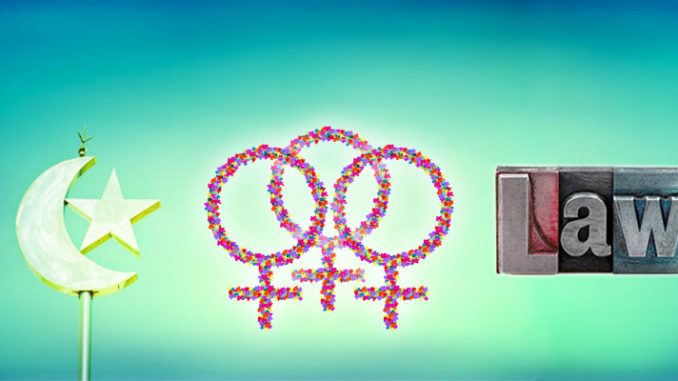
Hjh. Nik Noriani Nik Badlishah, editor
Islamic Family Law and Justice for Muslim Women
Malaysia / Sisters in Islam / 2003
Gender, Muslim Laws and Reproductive Rights
Davao City / Pilipina Legal Resources Center, Inc. / 2001
The essays in these two volumes deal unevenly with the issues of sexuality, reproductive rights, and gender violence in Islamic societies. There is, however, one thread that binds them all – that to be a woman and a Muslim is probably one of the most difficult positions to be in these days.
Like all women, Muslim women have to negotiate their relationship with men regarding issues of sexuality, reproductive rights, and the raising of their families. But gender relations are also mediated by larger, interacting, and often conflicting regulatory perspectives – the patriarchal system, Islam and its various interpretations, and the laws of the modern state.
Patriarchy, the State, and Religion
These mediations are most apparent in the comparative overview offered Sisters in Islam’s Islamic Family Law and Justice for Muslim Women of Islamic family law in Indonesia, Malaysia, the Philippines, and Singapore. This slim volume is a series of country workshop reports on what editor Hjh. Nik Noriani Nik Badlishah refers to as “areas of discrimination against women in the substantive provisions as well as the implementation of Islamic Law legislation.” The workshop, which included participants from Egypt, Jordan, Iran, Morocco, and Pakistan, as well as “activists, Syariah (Islamic law) lawyers, and policy makers,” also “highlighted best practices and put forward strategies for reform.”
The countries where the patriarchal system is deeply embedded in the “tradition” and further validated by Islamic teachings that subordinate women to men and allow them little autonomous identity (much less rights) are those whose state structures are often heavily centralized but weak, corrupt, and inefficient. Of the four countries covered by this book, the status of Indonesian Muslim women appears the worst.
For decades, no law governed husband-wife relationships except those laid out by influential religious organizations like the Hanbali school of law and the Syi’ah Imamiyyah; these decree the wife to be completely subordinate to the husband and “absolutely not entitled either to shelter or to financial support” should the husband decide to leave her. Attempts by Indonesian nationalists to introduce progressive measures in the early days of the Republic (especially banning polygamy) were easily derailed by these religious groups. The same associations led opposition to the compulsory registration of marriage.
It was only in 1970, five years after the Suharto dictatorship came to power, that the state began to deal with these issues. The Marriage Act and a Kompilasi Hukum Islam were passed, but even then, according to Indonesian participant Ratna Batara Munti, the law “has no connection with the issue of [the] legitimacy of the marriage.” Women are thus open to abuse since men can still “evade their responsibilities towards their wives and children.” While the Act and the Kompilasi are more explicit regarding the conditions with which a husband must comply before taking a second wife, Ratna argues that these “do not reach the roots of the problem of the sexual oppression of women and the perception of women as sexual objects and sexual-service providers.”
Sexual relations that privilege the husband are thus confirmed by both state and religious laws: the woman’s prime duty is “to be devoted physically and mentally to the husband.” In the event he wants a divorce, a husband can simply charge his wife with nusyuz (disrupting the marriage), bring in his witnesses, and be absolved of his responsibilities. She cannot appeal to the Syariah court which grants the divorce because its decisions are often final; neither can she go to the civil court and invoke her rights, because the Marriage Act was not designed to go beyond the registration of their marriage. Custody of children twelve or younger goes to the mother, but without provision for paternal support.
It is no wonder that among the Islamic countries of Southeast Asia, Indonesia has the highest divorce rates; the state has virtually no power over Islam, particularly its conservative and anti-women streams.
Contrast this to Singapore where the state is authoritarian but efficient, and state actors are honest and dedicated to their profession. As far back as the 1950s, Singapore had already defined (and limited) the scope of Muslim laws to cover only marriage, family, and succession. This definition was legalized through the Muslims Ordinance of 1957 and a Syariah Court was established a year later. In 1966, the Muslim Ordinance was replaced by the Administration of Muslim Law Act (ADMLA), which came into effect in 1968. The ADMLA became the institutional and administrative framework for the “efficacious application of legislation.”
Unlike in Indonesia, the Singapore state recognizes the “overlapping of jurisdiction between the Civil Courts and the [Syariah court]” and gives Muslims the option to choose which court to use in cases of divorce, child custody, and the division of property. This tends to level the playing field and provides Singaporean Muslim women a better opportunity to assert their rights and defend themselves in case of spousal abuse. It also affords Muslim women one right that conservative clerics are strongly opposed to – the right to marry outside of Islam.
The “efficiency” of the Singaporean state is most evident in explicitly stating monetary and other financial provisions. The amount for spousal support after divorce (mut’ah) starts at S$ 3.00 per day recently (up from an original S$ 1.00 per day). While this is “generally inadequate,” giving an amount nevertheless indicates the extent to which Islamic law has become heavily regulated. A positive consequence of this regulation has been the appearance of cases where wives demand a share of the husband’s contribution to the Singaporean Central Provident Fund, with the courts ruling generally in women’s favor.
What Singapore presenter Halijah Mohammad calls the “interposition of Muslim personal law and civil laws” may encounter the problem of the refusal of the Syriah Court to recognize decisions made by its civil counterpart, but she notes that to date no such problem has occurred. This is partly because Singapore’s authoritarian regime takes governing and political stability very seriously. Chapter 7 of the book is a detailed elaboration by Halijah of the changes introduced in the Syariah courts to reduce case backlogs and, more importantly, establish better order and routine in the presentation, deliberation, and decision-making processes of these courts. She admits that as a small country, Singapore finds it “easy to control the population and enforce court orders.” Size and a huge population should therefore be taken into consideration when evaluating Indonesia’s more backward state.
The two other case studies – Malaysia and the Philippines – can more or less be located between these two “extreme” examples.
There was little attempt to codify, much less integrate, Islamic laws into the broader Philippine legal system until the Moro National Liberation Front’s rebellion shook the dictatorship of President Ferdinand Marcos and compelled it to pass a separate Code of Muslim Personal Laws. This “recognizes the legal system of the Muslims in the Philippines as part of the law of the land and seeks to make Islamic institutions more effective.” It also “codifies Muslim personal laws [and] provides for [their] effective administration and enforcement.”
A separate code for Muslims, however, does not make the position of women unproblematic. As Norma A. Maruhon noted in her report, Islamic schools and teachers in the southern Philippines have differing opinions about marriage and gender relations, depending on which “Traditions of the Prophet” are cited. For example, the Code leaves open the issue of dowry (mahr), which Maruhon suggests can create problems when couples divorce. Likewise, the Code’s regulations only apply when women want to file for divorce. Men can divorce their wives by merely declaring talaq, verbally repudiating the marriage and sending a notice of intention to the clerk of the Court. While the wife can seek arbitration by an Agama (religious) council, the failure to codify this process allows for vagueness that Maruhom warns can be disadvantageous to her.
While Maruhom and Carmen Abubakar (another Philippine presenter) cite the many pitfalls of the Code, the main problems facing Muslim women are two: the poverty of the Muslim provinces and the inability of a weak, corrupt, and inefficient Philippine state to promote development, bring about stability and better governance, overcome Muslim suspicions towards the Christian-dominated state, and involve Muslim Filipinos more meaningfully in its programs and policies. The Muslim provinces that are now part of the Autonomous Region for Muslim Mindanao (ARMM) belong to the fourteen poorest provinces of the Philippines. Worse still, the capacity of the state to deliver social welfare is appalling. In the provinces of Magindanao, Basilan, Sulu, and parts of Lanao del Sur, people’s main association with the state is with its war machine – the Armed Forces of the Philippines.
Poverty and war combine to set up obstacles to women’s progress. Suspicion of the state or its absence means that women wanting to expand their roles and rights must contend with the conservative streams of Islamic thought on their own. Unlike in Malaysia or Singapore, there is no modern state to support them or help create a political space where women can push for gender equality.
Weak state capacities also affect enforcement. Isabelita Solamo Antonio reveals that while the Code orders husbands to support wives, Syariah courts are filled with cases of “wives demanding support for themselves or for their children or both.” Not only are the courts crowded (here is Singapore’s advantage); they also lack the power to enforce compliance with their rulings.
Still, the codification of Muslim personal laws has led to specific clarifications of the rights and obligations of both husband and wife. The Code makes it difficult for men to marry again, for they have to show they “can deal with [both wives] with equal companionship.” Property distribution in the event of separation appears fair and the wife is allowed her own property. Finally, child custody favors the mother.
Malaysia inherited from the British colonial era “a dual system of courts.” Civil courts have jurisdiction over “the majority of laws including contracts, torts, property, and succession to property, crime and constitutional and administrative cases,” while Syariah courts cover “Islamic family law and have jurisdiction only when the parties are Muslims.” In the 1970s, the Malaysian government introduced legal changes that eventually shifted the jurisdiction of Islamic family law to the state level “except with respect to the Federal Territories.” The federal Islamic Family Act of 1984 further clarified this devolution of power but also – as in Singapore – institutionalized marriage and divorce procedures.
The devolution of Islamic family law to the local states, argues Nik Noriani Nik Badlishah, has been problematic: “there are [now] 14 separate jurisdictions (including the Federal Territories) on Islamic family law.” Conflicting regulations are inevitable, like the clash between Section 13 of the Islamic Family Act, which “requires the consent of both parties to the marriage or the consent of either the wali [guardian] or Syariah judge where the woman has no wali,” and Kelantan state’s 1993 Islamic Family Law, which undercuts the rights of the most vulnerable. This law says “the bride’s consent is wajib (obligatory) if she is not a virgin or if she is a virgin whose wali is not mujbir (her father or paternal grandfather).” The bride’s consent is simply recommended (sumat) “if she is a virgin whose wali is mujbir.”
Nik Noriani traces the origins of these provisions to “the traditional Shafi’i view of the doctrine of the ijbar (compulsion) and rights of wali mujbir to exercise compulsion subject to certain conditions.” This doctrine, Nik Noriani argues, has faded in importance in the Muslim ummah, and even Middle Eastern countries have banned compulsory marriage. In this light alone, the Kelantan law is “absurd and illogical” – all the more so in a community with no strong patriarchal system where women had traditionally been independent.
Devolution has also caused problems relating to polygamy. It has made it easier for men “to go to another State to contract a polygamous marriage and later apply for registration rather than…apply to the court for prior permission,” which is what the federal law requires. To prevent such abuse, the Islamic Family Law Act imposed conditions on husbands seeking to take another wife; these include the first wife’s “sterility, physical infirmity, physical unfitness for conjugal relations, willful avoidance of an order for restitution of conjugal rights or insanity.” The husband must also show that he “has the means to support all his wives and dependents,” can accord them equal treatment, and ensure that the new marriage “would not cause darar syarie (harm) to the existing wife.” The 1994 amendment to the Act requires that polygamous marriages be registered “even though they were contracted without [a] court’s permission.”
Here we notice the contradictions encountered when a state over-extends federalism in an attempt to incorporate Islamic laws. Federalism was the only way the Malaysian state could maintain control over its disparate territories, especially on its borders. But in trying to parallel administrative efforts to promote local autonomy, the central government may instead have created a chaos of conflicting interpretations that could affect the ability of women to push their agenda.
Already, when groups like Sisters in Islam try to initiate changes in the law for the betterment of women, they have been accused of being “pro-Western” or “anti-Islamic.” These criticisms have been mitigated so far by adroit coalitional politics amongst the women’s groups and with politicians and bureaucrats. But the danger exists of all these improvements going to waste, due to both the limits on democracy exercised by this one-party regime and the increasing shift towards Islamic conservatism by many Muslim groups.
Justifying Reform
All the country reports include suggestions about how to reform the existing codes. These are mostly concrete proposals, including one recommending pre-nuptial agreements. Amina Wadud’s essay (Chapter 9) provides the theoretical justification for pushing for reform in gender relationships inside Islam.
The core of her argument involves theorizing the concept of khilafah (woman’s full agency). Khilafah is “not a chapter, a verse, a hadith or specific operation,” argues Wadud. It is a theory, “a state of mind,” and a perspective. As a theory, it derives its foundations from the tawhid (“the harmony in and unity of all creatures under a single Creator”), but Wadud also recognizes that it exists and operates in a specific “social and political context.” She then proceeds to the crux of her reformist position by asking a direct question: “How are women treated by individual men and by Muslim patriarchy as a whole? If the answers to this question show grave inequalities, then the need for reform is justified.”
The next step is to figure out “the cause of this inequality” and why women are “in an inferior position in Muslim society.” Is it because of Islam? Wadud deploys hermeneutics and history to show how the non-involvement of women in the “formation of Islam’s paradigmatic foundations” led to a situation where “men and men’s experiences of the world – including their experiences with women – [have come to] determine how Islam is defined for themselves [and] for women. In other words, men have proposed what it meant to be Muslim on the very presumption that the male experience is normative, essential and universal.”
This, for Wadud, is what should be changed, arguing that the revelations of the Prophet Mohammad are also “affected by context, perspective and experiences” and thus subject to changing interpretations. Wadud closes her essay with a caution that any attempt to reform gender relations inside Islam must be done with a full understanding of the theoretical perspectives of the proposed reforms and the ideational foundations of the worldview(s) reformers wish to change. She warns: “Haphazard actions can only produce haphazard results.”
Ziba Mir-Hosseini complements Wadud’s essay by pointing out areas where reformers can make a stand. She argues that because “conceptions of gender rights in Islamic law are neither unified nor coherent, but competing and contradictory,” there are openings in the public sphere into which women can introduce reforms. Like Wadud, Mir-Hosseini opens her essay with a puzzle: “if justice and fairness are indisputable objectives of Syariah, should they not be reflected in laws regulating relations between, and the respective rights of, men and women? Can there be an equal construction of gender rights in Islamic law? If so, what are the strategies needed to achieve it?”
She makes a crucial distinction between the Syariah, which she refers to as “the totality of God’s law as revealed to the Prophet Mohammad,” and fiqh, which “is not part of wahy (divine revelation) [but] part of religious science whose aim is to discern and extract Syariah legal rules from the Qur’an and the Sunnah.” As a “legal science with its own distinct body of legal theories and methodology as developed by [Muslim jurists] over the course of centuries and in dialogue with other branches of religious and non-religious sciences,” the fiqh is open to changes in interpretation. It is in this area where women reformers have, as it were, a fighting chance.
Mir-Hosseini proceeds to an overview of the various Islamic “discourses” and how gender (in)equality figured in each of these. In the “classical fiqh” one finds the genesis of gender inequality; here it is taken for granted that women are not equal to men. Islam’s encounter with western colonial powers led to a shift in discourse as the “status of women” became a “contested issue” in the confrontation between traditionalism and modernity. The emergence of nation-states in the Islamic world transformed the fiqh again as “legal rules on family and gender rights were selectively reformed, codified and gradually grafted onto a unified legal system.”
The struggle for reform shifted from the larger religious community to the nation-state even as leaders of the new political order themselves struggled with the issue of religion and politics. Certain countries abandoned the fiqh as a sole basis of the law, moving it into the personal sphere and replacing it in the public sphere by western law. (Turkey is a prime example.) Others have preserved the fiqh and invoked western legal codes only insofar as they supplement and do not challenge thefiqh (the Gulf countries). Mir-Hosseini calls this a shift to neo-traditionalism, because this discourse effectively erases women’s right to actively participate in religious and political life. Even the “classical fiqh” had once allowed this. Neo-traditionalists now argue that gender has no place in Islam and that women must be totally subordinated to men. Mir-Hosseini traces the origins of the widespread belief that only men have the right to divorce to this neo-traditionalist school.
In the late twentieth century, however, a reformist discourse emerged. It “contends that the human understanding of Islam is flexible, that Islam’s tenets can be interpreted to encourage both pluralism and democracy, and that Islam allows change in the face of time, space and experience.” A vital articulator of this reformist discourse is a small but growing band of Islamic feminists “that takes Islam as the source of its legitimacy” but “challenge[s] the hegemony of orthodox interpretations and questions the legitimacy of the views of those who until now have spoken in the name of Islam.” The ability to push a revisionist view of Islam was ironically made possible by “appealing to the believer’s logic and reasoning, relying on arguments and sources outside religion, and imposing their vision of Islamic law through the machinery of the modern state.”
And perhaps herein lies a weakness of this still incipient reformist stream within Islam. For in many Islamic countries, the modernization of the state has entailed the further restriction of individual and group rights and the limitation of certain basic freedoms in the name of development. The successes of the countries in these studies have much to do with leaders (majority male) who modernize their societies through industrialization, regard governance as a top-down affair, and believe in the state having firm control over social forces. Even Turkey’s vibrant democracy is anchored on the unquestioned presence of the military.
Strategies for reform, therefore, are not only opposed by conservatives and neo-traditionalists. Reformers may also have to deal with state leaders’ suspicion of change emanating from below. It appears that the most successful reformers are those who can make accommodations with state leaders and push for gender reforms without transforming these into a call for broader political change. The case of Malaysia may be most illustrative here.
If reform efforts at the level of theory already face some difficulty, all the more so when it comes to the issue of reproductive rights and women’s control of their sexuality.
Sexuality
Gender, Muslim Laws and Reproductive Rights is a slim volume of workshop papers that covers issues of reproductive rights and female sexuality in Indonesia and the Philippines. There is unanimous agreement that women in these two countries have a long way to go before they attain a similar level of control over their bodies as that enjoyed by their western counterparts. Not only is there considerable opposition from male-dominated Islamic schools and institutions, but the nationalization of Islamic discourse, as Mir-Hosseini pointed out, has also become an unwitting barrier for Islamic women to organize a region-wide movement.
What is interesting in this group of papers, however, is that they confirm theoretical arguments made by feminists in the first book: that there is basis in Islamic thought for women to transform khilafah from a mere citation into a worldview. Early Islam, as Michael Tan notes, accorded women property rights and a say in marriage and divorce. Filipina Muslim Bagian Aleyasa Abdulkarim embodies the reformer that Wadud and Mir-Hosseini talk about – an Islamic feminist who adeptly combines the global discussion of women’s rights with various hadith that show how Islam values khilafah.
The discussion of sex is particularly overt in this volume. Abdulkarim and Indonesian activist Lily Zakiyah Munir quote the same hadith to show the value placed by the Prophet Mohammad and his early interpreters on a woman’s sexuality. Women, according to one hadith cited by Abdulkarim, not only have the right to enjoy sex, but can also refuse sex (p. 25). She cites the revered Islamic teacher Ibn Majah’s invocation that men must “pay complete attention to her needs [and] in the event that the man (husband) has fulfilled his desires (reached orgasm) before his wife, he should not leave her in haste but stay until she reaches her orgasm.” (Munir cites the same statement although her translation goes like this: “If one of you has an intercourse with his wife then he should pay attention to her needs seriously, so that whenever he comes to orgasm before she does, he should not withdraw… until she comes to orgasm.”)
But these daring statements are tempered by qualifications. After quoting Ibn Majah, Munir immediately cites the teaching of Sufi scholar Al-Ghazali, which describes marriage as “a form of enslavement.” She does not confront these reactionary ideas head-on but merely puts them alongside other hadith supportive of female sexuality. This even-handedness suggests that the forces she and others confront are still powerful. But by putting the two views alongside each other, she gives readers a glimpse of teachings and interpretations that dominant Islamic discourse tries to suppress and marginalize. A classic weapon-of-the-weak posture.
Others are not as bold. Carmen Abubakar argues that any discussion of “reproductive health or reproduction in general cannot take place outside the bonds of marriage.” Abortion is recognized, but only within the rubric of the “Islamic Rule of Necessity.” Abubakar cites the “fatwa of Ibn Taymiya,” banning only those contraceptives deemed harmful to a woman’s health, but reveals her conservatism when she qualifies that she and others “are finding out that many of these contraceptive methods are indeed harmful over a long period of use.” Well, so too are pain medicines or cancer treatment.
There is very little that the essays can be conclusive about. What is notable about this volume are the many times its authors hedge or steer clear of definitive arguments. Despite the admirable and daring arguments presented in both these collections in favor of expanding women’s rights in Islam, conservative forces have the upper hand in the politics of most Muslim societies today. If reformists and Islamic feminists do have a political presence, they are one of many voices or a minority bloc in a political arena dominated by conservatives.
Patricio N. Abinales
Patricio N. Abinales is associate professor at the Center for Southeast Asian Studies, Kyoto University
Kyoto Review of Southeast Asia. Issue 5 (March 2004). Islam in Southeast Asia



